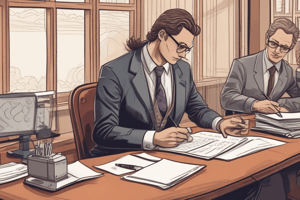Podcast
Questions and Answers
Where should the sender's address be placed in a formal letter?
Where should the sender's address be placed in a formal letter?
- On the right side of the page, aligned with the margin.
- At the bottom of the page, after the sender's name.
- On the left side of the page, just next to the margin. (correct)
- Centered at the top of the page.
What is the correct placement of the date in a formal letter?
What is the correct placement of the date in a formal letter?
- Below the receiver's address.
- Above the sender's address.
- At the bottom of the page, after the closing.
- Below the sender’s address, after leaving one line. (correct)
Which of the following best describes the purpose of the 'Subject' line in a formal letter?
Which of the following best describes the purpose of the 'Subject' line in a formal letter?
- To thank the recipient for their time.
- To state the sender's contact information.
- To provide a brief summary of the letter's main point. (correct)
- To formally greet the recipient.
In what order should the receiver's address, date and salutation appear in a formal letter?
In what order should the receiver's address, date and salutation appear in a formal letter?
What should be included in the first paragraph of the body of a formal letter?
What should be included in the first paragraph of the body of a formal letter?
What is the primary function of the second paragraph in the body of a formal letter?
What is the primary function of the second paragraph in the body of a formal letter?
What is the purpose of the third paragraph in the body of a formal letter?
What is the purpose of the third paragraph in the body of a formal letter?
Which of the following is an appropriate complimentary closing for a formal letter?
Which of the following is an appropriate complimentary closing for a formal letter?
After the complimentary closing, what information should be included?
After the complimentary closing, what information should be included?
What is the MOST appropriate salutation to use when writing a formal letter to an unknown recipient?
What is the MOST appropriate salutation to use when writing a formal letter to an unknown recipient?
Flashcards
Sender's Address
Sender's Address
Located on the left side of the page, next to the margin, this is where the sender's address is written.
Date in a Letter
Date in a Letter
Written below the sender’s address, indicating when the letter was composed.
Receiver's Address
Receiver's Address
Placed after the date, this is the address of the person or entity to whom the letter is addressed.
Subject of the Letter
Subject of the Letter
Signup and view all the flashcards
Salutation in a Letter
Salutation in a Letter
Signup and view all the flashcards
Body of a Letter
Body of a Letter
Signup and view all the flashcards
Complimentary Closing
Complimentary Closing
Signup and view all the flashcards
Sender’s name/signature
Sender’s name/signature
Signup and view all the flashcards
Study Notes
- When writing a letter, the sender's address goes on the left side, next to the margin.
- The date is written below the sender's address, after leaving one line.
- After the date, include the recipient's address, such as "The Officer" or "The Principal".
- The subject of the letter should be the main purpose which needs to be stated in 4-5 words.
- Use "Respected Sir / Madam" as a salutation.
- The body of the letter should explain the matter and be divided into three paragraphs.
Body Paragraphs
- First Paragraph: Briefly state the letter's purpose.
- Second Paragraph: Include the detailed matter.
- Third Paragraph: Provide a conclusion or solution to the topic.
- Use a complimentary closing or subscription, such as "Thank you," "Yours truly," or "Yours sincerely."
- Include the sender’s name/signature and designation, if applicable.
Studying That Suits You
Use AI to generate personalized quizzes and flashcards to suit your learning preferences.




